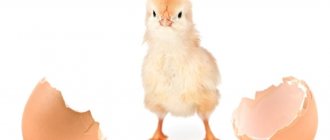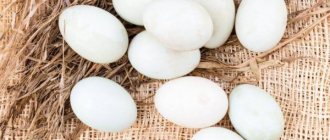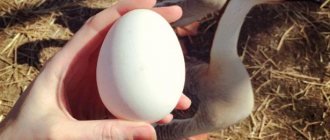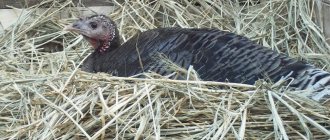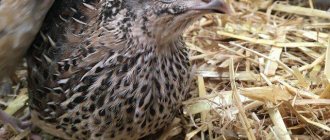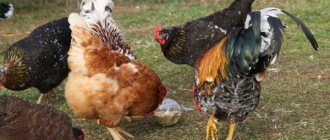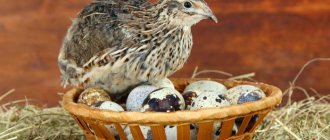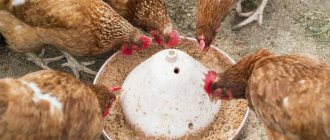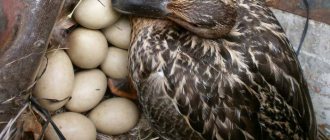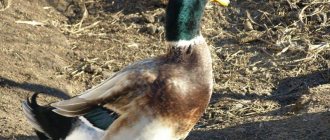Features of egg production
Mute or Indian ducks can gain impressive weight, especially for males. By the thirteenth week of their life, drakes gain about 4.5 kg, and ducks - 2.5 kg. Therefore, in most households, mute dogs are bred exclusively for meat. However, their egg production is also quite good. In addition, its calm disposition and simplified maintenance requirements have helped the breed earn respect in many small farms.
When does laying begin?
The Indian duck begins to lay eggs when she becomes sexually mature. This period begins at approximately 6-7 months. Since mute birds are heat-loving birds, if kept in good and warm conditions, egg laying may occur earlier. Accordingly, under bad conditions - a little later. A deviation of up to 1 month is considered normal, but sometimes it can be longer. Like most poultry, the Indian duck will not lay eggs all year round, but only two short periods a year.
Thus, the need to lay eggs in these birds appears in spring and autumn. Laying lasts one and a half to two months each cycle. Some breeders, when egg production begins in mute cats, try to do everything to increase it. But, as practice shows, the results are not worth spending so much effort on them.
How many eggs does it lay?
Many people are interested in how many eggs musk ducks can lay per year and is it worth keeping them for the eggs? Based on the fact that Indian ducks are a meat breed, their egg production is even very good. So, per year it turns out from 80 to 120 pieces. eggs On average, the weight of the product ranges from 70 to 75 g. Eggs are almost always white, with a barely noticeable bluish tint.
The shape resembles an oval slightly flattened at one edge. In size - slightly larger than chickens. The yolk is almost always larger than that of chicken eggs. The nutritional value of such a product is also much greater than that of chicken. So it is possible and even necessary to breed mute birds for eggs.
Loading …
How long do chicks hatch?
Indo-ducks hatch their ducklings for different periods of time, but on average it is about a month or 29-35 days. This process must be approached with all seriousness. The place needs to be prepared warmer and the incubation must be monitored from start to finish. In most cases, you don’t have to worry, because nature intended it so that mute birds are good hens, but bad mothers. Therefore, until the chicks hatch, you can count on the duck to handle everything herself.
How many eggs should I put under a mother duck?
As soon as you notice that your duck has become ruffled, walks around hissing and drives everyone away, it means it is preparing to hatch its offspring. The first step is to prepare the nest by adding more hay or other bedding. Now you need to decide how many eggs to put under it? In most cases, the duck applies the required amount to itself, which is approximately 20 pieces.
But it is better to control this process, because it often happens when all the eggs do not fit under the duck or half of the eggs are old and unsuitable for incubation. In this case, you need to regularly remove the product from the nest, so that only fresh eggs can be added later. Now let's look at the question, how many should we put in there? Here, to a large extent, everything depends on the size of the brood duck.
The whole point is that the bird must calmly cover all the eggs with its body. Only minimal product peeking out from under the plumage is allowed when the turkey sits. Therefore, it is recommended to put from 8 to 12 pieces for a small individual, and 15-20 pieces for a large one. Experienced breeders do not recommend placing more than 15 eggs. The norm is considered to be no more than 5 pieces. from those placed will be rejected during the hatching process.
At what age do Indian ducks begin to lay eggs for the first time?
Reaching sexual maturity occurs at 6 or 7 months of age, but values may decrease or increase depending on the conditions in which the ducks are kept.
Indian ducks prefer warm areas, because it is there that they reach sexual maturity earlier and begin to lay eggs earlier. If birds are kept in a cool room, the period for obtaining eggs may be delayed by a month or more.
One drake needs four ducks, no more. For a good clutch, it is better to choose a drake 1-2 months older.
Did you know? In fact, these birds are called Muscovy ducks, only in the territory of the former USSR they are called Indian ducks. This name gives the wrong impression that the birds are hybrids of a turkey and a duck. Most likely, the ducks were given this name due to the presence of growths on their heads, similar to those of a turkey.
Typically, the number of eggs obtained per year is from 80 to 100 pieces weighing up to 70 grams. There is a strong relationship between age indicators and masonry. Moreover, changes are observed almost monthly.
6-7 months
A six-month-old duck is just entering puberty, so the first clutch is small, about 6-8 eggs. But you can put eggs under the hens, as they are very good hens.
7-9 months
Within a month, the number of eggs increases sharply. From this time on, the clutch size increases from 15 to 20 pieces per period. Sometimes it happens that all the testicles simply do not fit under the duck, so they are recommended to be placed under young ducks of six months of age, as indicated above, or placed in an incubator.
9-11 months
This period is considered the most prolific. The clutch contains from 25 to 30 eggs, sometimes even more.
Important! It is at this age that it is advisable to plan to replenish the family by breeding ducklings. There are several reasons why ducks do not want to lay eggs or hatch eggs.
Much depends on the conditions in which the birds are kept. Natural processes and diseases can also affect masonry.
There are several reasons why ducks do not want to lay eggs or hatch eggs. Much depends on the conditions in which the birds are kept. Natural processes and diseases can also affect masonry.
Shedding
After each laying, ducks begin to change their plumage - this is a normal physiological process that ends after two months. But for some reasons it may be delayed, since the molting period is individual.
And it is quite natural that the bird refuses to lay eggs until this period is over.
The resumption of reproductive functions depends on how the duck feeds and in what conditions it lives (including air temperature and room lighting).
Important! The first molt of a bird begins at the age of three months. It is very important to monitor the conditions in which the young individual lives, so as not to miss or delay the period of the first clutch
Laying hens must be given plant feed with vitamin and mineral components. Especially in winter and autumn, since at this time the deficiency of active elements in the body worsens.
If you maintain good nutritional conditions, egg production will be high, duck meat will be tasty and there will be no digestive problems
But if you have one of these problems, you should pay attention to what the bird eats
If ducks do not want to lay eggs, you should make sure that they get enough vitamins. Particularly important for life are:
- Vitamin A. Affects the intestinal system, respiratory tract and eyes. Contained in milk, fish oil and yolk, carrots and herbal meal. It is advisable to include any of these products in your diet;
- vitamin D, which prevents various diseases. You need to give yeast or fish oil;
- vitamin E. It is the most important, as it affects the functioning of the reproductive system and activates the intestines, removing everything unnecessary from the body. Contained in green peas, tomatoes, carrots and spinach. You can also include clover, alfalfa, nettle or any flour from these herbs in your diet.
Typically, the number of eggs obtained per year is from 80 to 120 pieces weighing up to 70 grams.
In a warm poultry house, the first eggs appear in mid-February, and if the room is cold, eggs should be expected later.
With proper care, the Muscovy duck lays up to 120 eggs annually. The weight of the egg reaches 60-70 grams.
Features of duck egg laying
To understand when to start preparing the nest and finding a brood hen, you should know the “general mechanics” of duck egg laying. It depends on the breed, but the differences between the numbers for different breeds are not particularly large. It is worth remembering that even egg breeds of ducks are inferior in the number of eggs per year compared to chickens. But duck eggs are much larger than chicken eggs (sometimes even 2 times) and cost an order of magnitude more. There is a benefit in each case.
Comparison of duck and chicken eggs
When does laying begin?
Different breeds of ducks enter the laying period at different times. This may also depend on weather conditions, diet, living conditions, and lighting in the poultry house. In a normal situation, the first testicle appears when the duck is 140-160 days old. If some negative conditions are observed (for example, too cold or hot), the period may increase to 200 days.
In a clean, well-equipped poultry house, egg laying begins earlier
The period can be reduced by improving the living conditions of the birds. But this is not recommended if ducks are kept for meat. The onset of egg laying should be artificially brought forward only when breeding ducks exclusively for eggs.
How many eggs does a duck lay per year?
The productivity of different breeds is quite different:
- meat breeds bear no more than 120-150 pieces per annual cycle;
- in meat and egg ducks, the clutch size increases to 180, in rare cases up to 200 pieces per year;
- egg breeds produce up to 220, and sometimes up to 250 eggs annually.
Indian eggs
Prices for ovoscope
Ovoscope
If we talk about the most popular meat and egg breeds (musk, Pekinese), then they lay up to 180 pieces under good conditions, and if kept in poor conditions - no more than 140 pieces.
Influence of age and breed characteristics
The maximum amount of production is obtained from females at the age of 2 years; it is not advisable to keep birds for more than 3 seasons. Among the breeds of domestic ducks, there are their own record holders for egg production, for example, Peking. The ancient breed, bred in China, is capable of producing up to 300 eggs per year. Over the years of selection, the bird has lost its brooding instinct; ducklings are hatched using incubators.
The Muscovy duck, popular among poultry farmers, is closest to its wild relatives. Its masonry has a pronounced seasonality (begins in spring and ends in late autumn). During the year, the musk duck lays no more than 120-130 eggs. But the bird is a good hen and a caring mother.
Approximate time when ducks start laying eggs
If you pay attention to the difference in the living conditions of wild and domestic laying hens, you will notice a difference in their egg production. Poultry, which does not have to independently obtain food and fight for life, lays about 120 eggs per year.
The poultry farmer can easily calculate the approximate number of eggs and the influx of flocks based on this data.
Domestic ducks begin to lay eggs when they are on average 150 days old. There may be errors when a bird lays an egg earlier or later than average.
In addition to age, egg production is also influenced by other factors, including the main ones:
- What conditions do birds live in? How suitable are these conditions for the bird to start laying eggs? The poultry house should be spacious, ventilated and, most importantly, warm. In order for birds to lay eggs, a temperature of at least 8°C is needed.
- Physical condition of the duck. Without health, ducks are unlikely to lay eggs. They should eat well, be “in body”, but not overfed. Unsuitable maintenance and diseases have a bad effect on the smoothness of the plumage, the color of the beak and legs. The latter should be painted bright orange.
Feeding issue
The basis is corn, which birds eat with particular passion. You can mix macadamia (in small quantities), fodder beets along with tops. Leftover food from the kitchen will also work. You can supply sprouted barley and wheat. It is sometimes useful to add fish and meat and bone meal, eggshells.
Cabbage is good during the molting period. Greens can be brought from the mowing, but direct access to the pasture is better. There is no need to graze them on purpose; they do it on their own. This distinguishes them from ordinary geese.
Muscovy duck diet per head
| Feed | Season | |||
| Winter | Spring | Summer | Autumn | |
| Wheat | 30 g/day | 60 g/day | 30 g/day | 10 g/day |
| Barley | 20 g/day | 20 g/day | 30 g/day | 20 g/day |
| Oats | 20 g/day | 20 g/day | 20 g/day | 20 g/day |
| Meat and bone meal | 10 g/day | 15 g/day | — | — |
| Hay flour | 20 g/day | 15 g/day | — | 30 g/day |
| Beet | 20 g/day | — | — | 30 g/day |
| Potato | 30 g/day | 40 g/day | — | 60 g/day |
| Silage | 20 g/day | 20 g/day | — | — |
| Mineral supplements | 8 g/day | 12 g/day | — | 5 g/day |
| Salt | 1 g/day | 1 g/day | — | 1 g/day |
| Wheat bran | 15 g/day | 30 g/day | — | 10 g/day |
| Total: | 194 g/day | 233 g/day | 88 g/day | 186 g/day |
Birds love to splash in the water and peck sand. We must ensure that these products are available in the access area. It is advisable to ensure that the birds do not swallow anything dangerous or sharp with the sand; it is better to limit the entry of such debris into the yard. The Muscovy duck is very profitable - it eats little, grows steadily, and lays eggs well.
Other recommendations
In order for ducks to produce more eggs and not stop laying eggs, experienced poultry farmers advise the following:
- During the productive period, you should not suddenly change the diet of the female or relocate her. This will cause stress, which may delay the onset of laying or reduce the number of eggs.
- You can determine that white ducks are ready to lay eggs by the changed color of their beaks and paws. They turn bright orange.
- Birds finish flying early in the morning. If you plan to hatch ducklings, in the cold season it is better to collect eggs at 5–6 o’clock in the morning. This will prevent hypothermia.
- It is recommended to change the nest litter daily to prevent the eggs from becoming too dirty.
- Do not be alarmed if the duck stops laying eggs during the molting period. This is a natural stage of feather change. After its completion, egg laying will begin again.
- Heat negatively affects bird productivity. They should have the opportunity to cool down - a pond in the paddock, a large container of water in the pen.
- Females need walks. Lack of movement leads to pathologies of the oviduct.
To obtain young animals, the poultry farmer needs to take care of the proper maintenance and nutrition of the ducks. This will allow you to get approximately 20-25 eggs per month. Egg production depends not only on care and feeding, but also on the breed and age of the bird.
Preparing optimal conditions for egg laying
During this period, special attention must be paid to keeping ducks. The egg production of birds largely depends on proper preparation for oviposition.
There are some conditions that must be met when ducks start laying eggs.
Preparing optimal conditions for egg laying
Complete and constant feeding
The feeding regime is established in advance of laying, approximately a month. Laying hens need to be fed 4 times a day, as during this period they need frequent meals. The more well-fed the birds are, the more eggs they will lay. The food should contain a variety of nutrients that are necessary for egg formation.
For a varied diet, the following are good:
- cake;
- bran;
- roots;
- milled wheat;
- crushed oats;
- corn.
It will be useful to start using succulent feed, created at home, during the period when ducks lay eggs. 1/5 of the diet can be greens - a mixture of nettles, clover, quinoa.
To gain weight, a duckling must consume feed containing animal fats. Low-fat cottage cheese, whey, bone and fish meal, boiled trimmings of meat, fish, and fish broth are suitable for this.
Increased daylight hours
This factor plays a fundamental role in the formation of the genital organs of birds. This must be remembered when discussing when ducks begin to lay eggs at home. The use of additional lighting will play a role here and will help the bird owner get the first eggs a little earlier.
The lighting level is increased little by little, in advance, before the start of masonry. Every day, the length of daylight should increase by no more than 20-30 minutes. Daylight hours can be extended in this way to 15 hours a day.
Light bulbs for lighting the room should be hung evenly, per square meter. The most commonly used bulbs are 700 lm. At night, electric lighting should be turned off, with the possible exception of low-power light bulbs.
Walking mode
When ducks start laying eggs, they need daily access to fresh air. Walks last 30-40 minutes. It is especially good if they walk near a pond.
Proper placement and conditions of detention
During the period of laying eggs, drakes must be separated from females. This is done because the male’s courtship disturbs the female. In exceptional cases, a laying hen may completely “forget” about the clutch.
In the room where ducks lay eggs, their density must be taken into account. There should not be more than 3 laying hens per 1 sq. A denser population will make it difficult for the birds to move; they will interfere with each other when feeding.
If there is a large number of birds, they will be placed in specially fenced off sections. One such compartment is designed for approximately 25-30 individuals. In order for the fertilization of eggs to be high, 5-6 drakes are needed per such plot. It must be remembered that an old drake is not suitable for fertilization.
Laying hen productivity dates
The lifespan of birds is 20 years , but the productive function lasts from 6 to 7 years, depending on the age at which ducks begin to lay eggs.
Be sure to read:
Everything you need to know about the diet and feeding of domestic ducks: experience and advice from experienced poultry farmers
Farms keep brood ducks for up to 3 years. In the first year, poultry productivity is low, but by the second year it increases by 5-10%.
Typically, the productivity of birds is related to the conditions of their detention.
Laying hens are selected based on appearance and condition. Healthy females have a powerful, well-proportioned body. The back of the abdomen of laying hens forms a rectangular line with the back; in non-laying hens the line takes on an acute angle.
All birds have an energetic character.
How many days does an Indian duck sit on her eggs?
I’ll answer the question right away: how long does an Indian duck sit on her eggs? The incubation period for musk ducks is 33 – 35 days; I will describe in more detail about the incubation of eggs by musk ducks in this article. Let me start with the fact that mute ducks lay eggs twice a year, usually one period takes place in the spring, and the second at the end of summer (beginning of autumn). During each period, the duck lays about 3 dozen eggs, after which it sits down to hatch its clutch.
If you want good eggs for hatching, the first step is to store them correctly. Very often, several ducks take turns sitting in one nest, even if there are several nests in the barn, several ducks can choose one nest at once and they will all lay eggs in one nest.
If the eggs are not removed from the nest in time, then the eggs laid at the beginning of the laying may sit for a long time, which will lead to their spoilage. To prevent this from happening, regularly take eggs from the nests, but leave a few marked eggs so that the ducks do not leave this nest, leave only fresh eggs in the nest, immediately take yesterday’s eggs from the nest. This way the eggs will not sit too long in the nest.
But, if only one duck sits in the nest at all times, then there is no need to take the eggs from the nest; one duck does not sit on the eggs. Try to fence off the nest so that it is not so noticeable to other ducks; you can cover the nest with a screen made of a piece of plywood.
While egg laying is in progress, duck eggs should be stored in a cool room at a temperature of about + 12 degrees; place the eggs in an open container, for example, a cardboard box. When the duck stops getting up from the nest, you need to place the collected eggs in her nest; this should be done in the evening so as not to disturb the hen too much.
How many eggs should I put under the turkey? Place enough so that the brood duck can cover them completely, if there are too many eggs, the duck will cover them in parts, while some are covered, others will be cooled, as a result, the incubation period will increase by several days, and some of the ducklings may not hatch. It is optimal to place a dozen and a half eggs under the duck, but you need to see if the duck is large, you can put more.
How long does an Indian duck sit on her eggs?
The process of hatching ducklings lasts much longer than chickens; if a hen hatches chicks for 21 days, then for musk ducks the hatching lasts from 33 to 35 days. I would like to note that the incubation period may increase by several days; this happens if there are a lot of eggs under the duck and they are not warmed up enough by the hen, or the weather is still cool outside, for example, in early spring.
During the incubation process, the duck periodically gets up from the nest, fresh water and food should be close to the nest, the container with water should be of sufficient size so that the duck can rinse in it, thus the brood duck moistens the hard shell of the eggs in the nest with wet down.
Important! You should not disturb the duck when it is sitting on the eggs, Indian ducks do not like this, check the eggs only when the duck gets up from the nest. Starting from the 30th day, you need to inspect the nest every day, check the eggs, hatched ducklings need to be taken out of the nest, immediately throw the egg shells out of the nest
You can inspect the nest when the duck gets up from the nest for a few minutes to drink water and peck food; if the duck does not get up from the nest, then inspect the nest early in the morning or late in the evening, when it is already dark.
Mute ducklings usually hatch from eggs within 3 days, the first being the strongest and the weakest being the last. If several ducklings have hatched, but there are still eggs left, then you need to check them, you can put the egg to your ear, if there is a living chick there, you will hear a rustling sound. Another sign is if the egg cools quickly in your hand, then most likely the chick has frozen, but the egg and chick remain warm for a long time.
When the poultry farmer knows how long the mute ducks sit on the eggs and the start date of hatching, he can count and determine the beginning of the emergence of ducklings from the eggs. At this point, you need to prepare a box with a heating pad for the ducklings in advance; as soon as the ducklings begin to hatch, they are transferred to the box on a warm heating pad.
Starting from the second day, ducklings are already taught to drink warm water (necessarily boiled), for this you need to take the duckling and gently wet it with its beak several times in a drinking bowl with water. You also need to start feeding the ducklings with millet and finely chopped boiled eggs, starting from the third day we add finely chopped grass to the food, the ducklings eat alfalfa and knotweed leaves very well.
When the duck has hatched all the ducklings, the ducklings from the box are placed next to her; it is advisable to keep the still weak ducklings in the box on a heating pad for a couple of days. Indo-ducks take very good care of their offspring, but you need to take care of their maintenance, make a walk for the duck with the brood, put out feeders and drinking bowls.
Where to keep ducks
A private yard is convenient for keeping birds. However, it is important for ducks to provide proper conditions. We are considering 3 options:
- It is possible to keep ducks outside in the southern regions. A cold-resistant breed is chosen for this. The habitat is covered with a canopy. However, the bird is able to stay outside 24/7 until the temperature drops to -3°C. As the frost increases, the ducks are driven into the barn.
- The greenhouse is considered an excellent poultry house. In winter, it is suitable for housing ducks, provided there is extensive glazing. Heating needs to be installed inside.
- The barn will play the role of a poultry house. The building needs to be insulated, the floor equipped, heating and ventilation installed.
It makes sense to build a separate poultry house when you decide to breed ducks on a long-term basis.
Preparing for incubation and birth of offspring
Sometimes the duck sits on the eggs itself, and sometimes you have to sit it down.
If a particular bird has a highly developed natural instinct, it can sit on eggs even in winter, after the first clutch. If this happened in winter, and by that time there are already several ten-day-old eggs, you can leave the bird on the eggs, but then you will have to add heat (heaters or stove heating) and increase daylight hours using artificial lighting.
Duck on eggs
The intention to hatch offspring can be assumed if the duck begins to line the nest with down. Then you need to give her several eggs (10-14 day old, you can’t take fresh ones). Farmers advise marking the entire clutch with a pencil or felt-tip pen to know how old the egg is. If fresh masonry appears in the nest, it must be removed, and then you can put it back.
You can only add whole, large or medium-sized eggs. If they are of irregular shape, have a defective shell or a crack, you should not take them. The testicles must be clean. You cannot wash them for hatching!
In the nest, the entire clutch should fit in one row under the duck. The excess needs to be removed.
Note! All manipulations in the nest must be done when the duck is not there (she has gone to eat or swim), when she does not see it. When the hen gets up, you need to remove fresh eggs and add the ones that have arrived. It is also necessary to remove debris from the nest and rotten embryos, if any.
But usually ducks themselves remove rotten or unfertilized eggs. Sometimes they eat them
It is also necessary to remove debris from the nest and rotten embryos, if any. But usually ducks themselves remove rotten or unfertilized eggs. Sometimes they eat them.
If not a single bird deigns to prepare a nest, the owner will have to choose a hen himself. From the entire flock you need to choose a calm, non-aggressive duck and test it. To understand whether the selected individual can hatch chicks, you need to carefully pluck some fluff from its breast and line the nest with it. 4-5 dummy eggs are placed in her nest. The dummy can be made of wood, plaster, or paraffin. The selected female is placed on eggs and locked in a nest or pen for 3-4 days, released 2-3 times a day to feed and bathe. If it is noticeable that the female is ready to hatch, you need to increase the frequency and volume of her feeding, and replace the dummy with real testicles.
Beginning farmers often do not know how long a duck sits on its eggs. On average, a duck hatches its offspring for about a month. The duration of incubation depends on the breed. Peking ducks sit for approximately 27-29 days, musk ducks sit longer - 30-36 days.
duck nest
How many days does a wild mallard duck sit on eggs? - on average, 26-28 days. Other wild breeds (Peganka, Gogol) hatch their offspring for 28-40 days. It should be noted that in wild individuals the brooding instinct is excellently developed; unlike all others, they take good care of both eggs and chicks.
Bashkir ducks incubate their chicks for about 28 days.
Mulard eggs are not suitable for hatching, since they are a hybrid, but females are quite suitable as brood hens.
Different species of birds can hatch different numbers of eggs, depending on their body size. Sometimes it happens that an individual sits on eggs and several eggs fall out from under it and stick out. Such embryos run the risk of never hatching.
Important! You should not place more eggs under the hen than she can hatch. About 12-20 future chicks fit under the female mute bird. The mallard lays and incubates from 7 to 12 eggs (no more than 12)
Bashkir ducks hatch 10-17 pieces. A female Pekin duck can hatch up to 20 eggs at a time
The mallard lays and incubates from 7 to 12 eggs (no more than 12). Bashkir ducks hatch 10-17 pieces. A female Pekin duck can hatch up to 20 eggs at a time
About 12-20 future chicks fit under the female mute bird. The mallard lays and incubates from 7 to 12 eggs (no more than 12). Bashkir ducks hatch 10-17 pieces. A female Pekin duck can hatch up to 20 eggs at a time.
Basic requirements for winter keeping ducks
Wild ducks have strong immunity. The bird is able to winter in unfrozen areas of the reservoir. Domestic individuals are more heat-loving. Some overseas representatives cannot tolerate frost at all. For example, Indian ducks freeze their paws at -3°C and can die.
The following requirements apply to keeping ducks of all breeds at home:
- The duck is considered a waterfowl; it breeds dampness even inside the barn. However, in winter it is important to maintain dryness as much as possible by frequently replacing the bedding.
- Each individual inside the house should have enough nests, drinkers and feeders. A shortage of one of the furnishings will lead to competition in the herd.
- It is important to minimize negative environmental impacts. The internal temperature regime should not depend on the outdoor temperature. The barn is equipped in such a way as to prevent drafts and precipitation from penetrating through the roof.
- The litter is poured in a thick layer. Organic matter will better absorb moisture and prevent your paws from freezing. Regular hay, sawdust, and straw will do. It is good to add peat to absorb liquid.
Domestic ducks left for the winter will lay eggs. Lighting will be installed inside the barn. Daylight hours are extended to 10 hours. Be sure to arrange a walk. In addition to the fence, you will need a canopy. The roof will prevent snow from covering the paddock. Additionally, the ground is covered with dry leaves, straw or hay.
Important! Ducks should not be walked in the snow. The bird quickly freezes its paws.
How to get chickens to lay eggs every day
If the genetic potential (breed) allows, create comfortable conditions for the livestock, and your pets will be pleased with large and tasty eggs every day. Shortly before the start of oviposition, transfer young individuals to the “adult” mode of life, having previously examined and assessed each bird. Nice young lady, looks like this:
- weighs at least 70% of the weight of an adult chicken (for example, if an adult of the Rhodonite cross weighs 2.5 kg, then a pullet at 4.5 months should have a mass of 1600-1800 g);
- has a developed, strong body, with a straight keel and a flat back;
- widely spaced legs (legs “X” - rough marriage);
- comb beginning to turn red.
Be sure to inspect the young animals for parasites (lice, ticks, fleas). If bald patches are visible on the skin and insects are noticeable, the pullet is treated with pyrethrum powder or Bars drops.
Clean the chicken coop immediately, wash the walls and whitewash them with lime. To prevent the appearance of parasites, I advise you to place fresh wormwood and tansy in the room. The smell of these herbs repels parasites and purifies the air in the room.
Expert advice Soboleva Elena Vladimirovna
Keep chickens in a light, dry and warm poultry house. Do not plant more than 4 individuals per square meter of floor; crowding provokes conflicts between residents and increases stress levels.
Inside the shed for laying hens, install perches and nests, arrange feeders (so that all individuals can freely approach the food) and drinkers.
Place nesting boxes measuring 40 by 50 cm on the floor or hang them on the wall in a dark and secluded corner. 3-5 hens can lay in one nest, that is, 3 nesting boxes will be required for a dozen laying hens. At the bottom of the nest, place fresh hay or soft straw, large shavings (small sawdust is not suitable, it creates a lot of dust). The litter must be changed periodically.
It is necessary to equip the chickens with a run. If the terrain allows: there are no stray dogs or birds of prey, no cars driving, and free-roaming laying hens will not spoil the plantings in the garden, let them roam freely. The chicken will not go far from home; it will graze nearby, eating grass and looking for insects.
If you cannot give the hens complete freedom, build a fenced run. Its dimensions are determined by the size of the plot; for 10 birds it must be at least 6 square meters. m. To protect against predators and cats, and to create a lacy shadow, pull a camouflage net on top.
Keeping your flock in a confined space, you will have to provide it with fresh grass, because the chickens themselves will not be able to get the vegetation.
Why don't birds land on the clutch?
Sometimes there are situations when an Indian duck regularly lays eggs, but categorically does not want to hatch the clutch. There may be several reasons for this bird behavior.
- Due to the fact that the bird's eggs are taken from the nest too often, she will not sit on them until their number reaches 20 pieces. Therefore, if there is not enough eggs, they must be added. You can lay absolutely any number of eggs, even if the female has only one of her own eggs. The main thing is to ensure that the bird begins brooding and continues it until the ducklings appear.
- Often the reason for refusal to hatch eggs is the presence of parasites or rats, which drive the bird away from the nest and begin to take away the clutch.
- It often happens that an Indian duck lays eggs rather poorly, but diligently hatches her offspring and remains in the nest as long as required. Such birds are immediately taken into account and left exclusively for hatching their offspring. And sometimes it happens the other way around - the female is highly productive, however, having laid the eggs, she immediately loses interest in them and does not sit on the clutch. This often happens with fairly young individuals, which is why they, like very old birds, should not be put on eggs, since in most cases they are not able to hatch chicks.
- Poor living conditions can also be a reason for an Indian duck’s refusal to hatch. Among the factors that negatively affect the female’s perseverance are too bright light, fuss in the house, or a poorly equipped and dirty nest. In general, Indian ducks have a strong maternal instinct, and therefore do not refuse to lay eggs without any good reason.
Feeding
One of the main factors influencing the period at which young hens begin to lay eggs is feeding. If daily nutrition is balanced, this will allow you to achieve early pregnancy with short breaks. To produce an egg, the hen's diet must contain nutrients and calcium. If they are not in the food, then the result will not work.
For this reason, if birds begin to lay eggs, they need good feeding. If the birds are in an aviary and their diet contains only grains, then the first clutch will occur one and a half months later. Nutrition affects the duration of the laying hen's productive activity. If the food is of poor quality, the chicken stops laying eggs much earlier.
White and brown hens have eggs of the same color. There is a myth that brown eggs are more natural and for this reason they are more expensive. In fact, brown eggs have a higher cost, because birds with brown plumage are larger and require more feed.
Care
In addition to the agreed upon aspects of caring for ducks in winter, there are also certain nuances that also need to be paid attention to. These include:
- do not allow the room temperature to drop for a long time to -5 degrees;
- daily ventilation of the poultry house, even if it is equipped with ventilation;
- open doors for ventilation only when ducks are walking;
- try not to create unnecessary drafts in the birds’ home;
- You need to do regular cleaning of the shed.
You also need to remember some features of ducks: they are rather shy birds and if you scare them, they may stop laying eggs for a while.
If such a situation occurs, then to calm them down, you can leave dim lighting in the house at night. One more thing: eggs are collected in the morning, since they are laid in the evening and in the morning.
However, if there are no eggs yet during the morning collection, then you should not let the birds go for a walk so that they do not lose the eggs. The ideal time to release birds into the aviary is 10 am. To everything mentioned, it should be added that ducks rarely get sick, therefore, with proper care and maintaining cleanliness in their home, no ailments will be scary for them.
